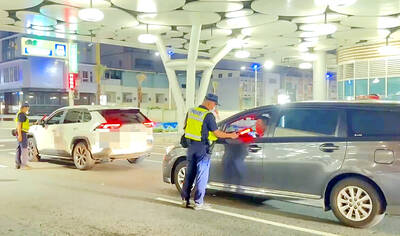The effectiveness of Taiwan’s fast-attack missile boats to counter the Chinese military will largely depend on the vessels’ ability to acquire targeting information, which might not be guaranteed in a full-scale war scenario, a defense expert said recently.
Unable to compete with the People’s Liberation Army Navy on a tonne-for-tonne basis, the Taiwanese Navy has in recent years embarked on an “asymmetrical” program, developing and fielding fast-attack boats equipped with a variety of surface-to-surface and anti-ship missiles.
Since 2010, three squadrons, or a total of 31 170-tonne Kuang Hua VI fast-attack missile boats, have entered service in the navy. Each boat is equipped with four Hsiung Feng II (HF-2) anti-ship missiles, which have a range of approximately 150km.
Since last year, the military has also begun modifications on some of its 500-tonne Ching Chiang-class patrol boats to outfit them with four Hsiung Feng III (HF-3) ramjet-powered supersonic anti-ship missile launchers. Five Cheng Kung-class frigates have also been outfitted with HF-3s as part of a NT$12 billion (US$406 million) program to arm the navy with 120 HF-3s, a 300km-range missile that since last year has been known as Taiwan’s “carrier killer.”
A new 450-tonne radar-evading fast attack corvette currently under development under a program known as “Hsun Hai,” or “Swift Sea,” is expected to be outfitted with eight HF-2 and HF-3 launchers.
Late last month, Chinese Nationalist Party (KMT) Legislator Lin Yu-fang (林郁方) told a meeting of the legislature’s Foreign and National Defense Committee that Hsun Hai vessels equipped with 650km-range HF-2Es would give Taiwan the ability to launch retaliatory attacks on Chinese military targets well beyond coastal areas.
The Hsiung Feng missile is produced by the Chung Shan Institute of Science and Technology. Taiwan’s development of cruise missile technology has proceeded despite opposition from the US, especially over the HF-2E, which Washington considers an offensive weapon.
Despite the missile boats being hailed as an effective way to counter China, some defense experts have said that the vessels’ reliance on off-board sensors for over-the-horizon (OTH) targeting to fully exploit the reach of their missiles could be their Achilles’ heel.
Those off-board sensors include AN-TPS-59 radars, which have a range of 740km and a variety of phased-array radars installed near missile bases.
AN-TPS-59 and 445km-range AN/TPS-75V radars are installed on Dongyin Island (東引島) of the Matsu island chain, just 45km off the coast of China’s Fujian Province. Defense News reported in 2010 that the radars bring Fuzhou Air Base and Longtian Air Base within their coverage, as well as the Nanping Missile Base and Xianyou Missile Base, where Dong Feng-15 ballistic missiles are deployed. The recently completed Shuimen Air Base is also within range.
Dongyin, as well as other shore-based radar sites on Taiwan’s offshore islands and Taiwan proper, would likely be among the primary targets of an attack by China.
“The true measure of effectiveness of the asymmetrical capabilities [of the fast-attack missile boats] rests with the robustness and survivability of the principally shore-based long-range radar network and the tactical datalink system,” a US-based defense expert told the Taipei Times recently, adding that it was far from certain whether such systems would remain viable in a full-scale war scenario.
Unlike China, the Taiwanese military does not have a -constellation of surveillance and tracking satellites, such as the Beidou navigation system, to provide homing coordinates for its cruise missiles. As such, by disabling the long-range radars or datalink systems used by the Taiwanese Navy to provide targeting information to the vessels, China could make it impossible for Taiwanese attack boats to effectively use their cruise missiles for OTH attacks on targets in China or at sea, thus negating the asymmetrical advantage.
Although unmanned aerial vehicles (UAV) can provide an alternative guidance and datalink platform, Taiwan is not known to have developed survivable mobile command-and-control centers that could receive information from UAV sensors or from a ground station and then assign target data to missile-carrying platforms at sea, the source said.
Another source told the Times yesterday that mobile radar systems, which the Taiwanese military possesses, would have better chances of evading or surviving at attack.
Taiwan has also reportedly shown interest in acquiring low-probability-of-intercept radars (LPIR), which are designed to be difficult to detect while tracking a target, the source said.

TRAFFIC SAFETY RULES: A positive result in a drug test would result in a two-year license suspension for the driver and vehicle, and a fine of up to NT$180,000 The Ministry of Transportation and Communications is to authorize police to conduct roadside saliva tests by the end of the year to deter people from driving while under the influence of narcotics, it said yesterday. The ministry last month unveiled a draft of amended regulations governing traffic safety rules and penalties, which included provisions empowering police to conduct mandatory saliva tests on drivers. While currently rules authorize police to use oral fluid testing kits for signs of drug use, they do not establish penalties for noncompliance or operating procedures for officers to follow, the ministry said. The proposed changes to the regulations require

The Executive Yuan yesterday announced that registration for a one-time universal NT$10,000 cash handout to help people in Taiwan survive US tariffs and inflation would start on Nov. 5, with payouts available as early as Nov. 12. Who is eligible for the handout? Registered Taiwanese nationals are eligible, including those born in Taiwan before April 30 next year with a birth certificate. Non-registered nationals with residence permits, foreign permanent residents and foreign spouses of Taiwanese citizens with residence permits also qualify for the handouts. For people who meet the eligibility requirements, but passed away between yesterday and April 30 next year, surviving family members

China Airlines Ltd (CAL) yesterday morning joined SkyTeam’s Aviation Challenge for the fourth time, operating a demonstration flight for “net zero carbon emissions” from Taiwan Taoyuan International Airport to Bangkok. The flight used sustainable aviation fuel (SAF) at a ratio of up to 40 percent, the highest proportion CAL has achieved to date, the nation’s largest carrier said. Since April, SAF has become available to Taiwanese international carriers at Taipei International Airport (Songshan airport), Kaohsiung International Airport and Taoyuan airport. In previous challenges, CAL operated “net zero carbon emission flights” to Singapore and Japan. At a ceremony at Taoyuan airport, China Airlines chief sustainability

‘ONE CHINA’: A statement that Berlin decides its own China policy did not seem to sit well with Beijing, which offered only one meeting with the German official German Minister for Foreign Affairs Johann Wadephul’s trip to China has been canceled, a spokesperson for his ministry said yesterday, amid rising tensions between the two nations, including over Taiwan. Wadephul had planned to address Chinese curbs on rare earths during his visit, but his comments about Berlin deciding on the “design” of its “one China” policy ahead of the trip appear to have rankled China. Asked about Wadephul’s comments, Chinese Ministry of Foreign Affairs spokesman Guo Jiakun (郭嘉昆) said the “one China principle” has “no room for any self-definition.” In the interview published on Thursday, Wadephul said he would urge China to